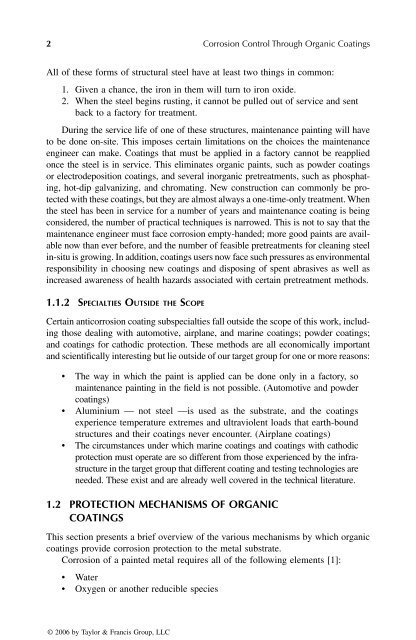© 2006 by Taylor & Francis Group, LLC
© 2006 by Taylor & Francis Group, LLC
© 2006 by Taylor & Francis Group, LLC
You also want an ePaper? Increase the reach of your titles
YUMPU automatically turns print PDFs into web optimized ePapers that Google loves.
2 Corrosion Control Through Organic Coatings<br />
All of these forms of structural steel have at least two things in common:<br />
1. Given a chance, the iron in them will turn to iron oxide.<br />
2. When the steel begins rusting, it cannot be pulled out of service and sent<br />
back to a factory for treatment.<br />
During the service life of one of these structures, maintenance painting will have<br />
to be done on-site. This imposes certain limitations on the choices the maintenance<br />
engineer can make. Coatings that must be applied in a factory cannot be reapplied<br />
once the steel is in service. This eliminates organic paints, such as powder coatings<br />
or electrodeposition coatings, and several inorganic pretreatments, such as phosphating,<br />
hot-dip galvanizing, and chromating. New construction can commonly be protected<br />
with these coatings, but they are almost always a one-time-only treatment. When<br />
the steel has been in service for a number of years and maintenance coating is being<br />
considered, the number of practical techniques is narrowed. This is not to say that the<br />
maintenance engineer must face corrosion empty-handed; more good paints are available<br />
now than ever before, and the number of feasible pretreatments for cleaning steel<br />
in-situ is growing. In addition, coatings users now face such pressures as environmental<br />
responsibility in choosing new coatings and disposing of spent abrasives as well as<br />
increased awareness of health hazards associated with certain pretreatment methods.<br />
1.1.2 SPECIALTIES OUTSIDE THE SCOPE<br />
Certain anticorrosion coating subspecialties fall outside the scope of this work, including<br />
those dealing with automotive, airplane, and marine coatings; powder coatings;<br />
and coatings for cathodic protection. These methods are all economically important<br />
and scientifically interesting but lie outside of our target group for one or more reasons:<br />
• The way in which the paint is applied can be done only in a factory, so<br />
maintenance painting in the field is not possible. (Automotive and powder<br />
coatings)<br />
• Aluminium — not steel —is used as the substrate, and the coatings<br />
experience temperature extremes and ultraviolent loads that earth-bound<br />
structures and their coatings never encounter. (Airplane coatings)<br />
• The circumstances under which marine coatings and coatings with cathodic<br />
protection must operate are so different from those experienced <strong>by</strong> the infrastructure<br />
in the target group that different coating and testing technologies are<br />
needed. These exist and are already well covered in the technical literature.<br />
1.2 PROTECTION MECHANISMS OF ORGANIC<br />
COATINGS<br />
This section presents a brief overview of the various mechanisms <strong>by</strong> which organic<br />
coatings provide corrosion protection to the metal substrate.<br />
Corrosion of a painted metal requires all of the following elements [1]:<br />
• Water<br />
• Oxygen or another reducible species<br />
<strong>©</strong> <strong>2006</strong> <strong>by</strong> <strong>Taylor</strong> & <strong>Francis</strong> <strong>Group</strong>, <strong>LLC</strong>
















